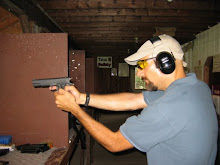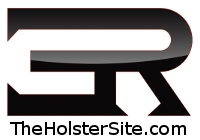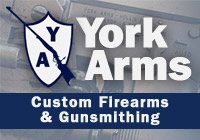Okay.
I have come to the realization that it is time to start thinking about learning to reload.
One of the major advantages of finally getting off my duff and joining the local gun club is that I've been shooting more (well, not recently, but...). One of the disadvantages is that... I've been shooting more. Shootin' is 'spensive, bubba. And .22LR, while a lot of fun, gets pretty boring after a while...
So I've decided that it's time. It is time to take the plunge and explore the crazy and exciting world of reloading. A new friend has generously offered to take me under his wing and guide me through the process, which is a good thing - I'm somewhat skittish about this undertaking, as I've seen plenty of examples of what can go wrong. One of the big reasons I've stayed away from reloading is that it requires a significant amount of concentration and dedication that I haven't yet been able to devote.
Well, I've decided I'm ready.
So I need a primer (HA! A reloading pun!) on getting started. What's a good set-up for a beginner reloader? Is there one set-up that's good for both rifle and pistol rounds? I shoot a LOT more pistol than rifle, but a lot of that has to do with cost (on average, pistol rounds are significantly cheaper than rifle rounds). For example, I'd love to take the Marlin 336 out to the range more often (I've shot it once, I think), but at $15 - $20 for a box of 20 rounds it's just too pricey.
Another reason is the indoor range at the gun club - we're only allowed lead bullets, no jacketed ammo of any kind allowed. While I can get plenty of .38 special wadcutters, that's about the limit of readily-available lead rounds for the guns I own. It would be nice to work up some .45 ACP wadcutters for the 1911s (even I, a complete farmer, know not to run lead reloads through a Glock) or some .380 ACP for the Makarov (which will digest pretty much anything I put into it. I have a sneaking suspicion I could load a 50 year old hollowpoint soaked in penetrating oil into this gun and it would still fire. In backwards.).
This is a multi-tiered bleg for my reloading readers. First off, what's a good, sturdy, inexpensive set-up for an introduction to reloading? Actually, back that up. What the heck is the difference between a single-stage press and a progressive press? What are manufacturers to look for or avoid? What the heck are die sets? What other equipment am I going to need? Brass tumblers, kinetic bullet pullers, dies, resizers; there's a brave new world of gear and lingo I need to learn before I even get started...
Secondly, before I go crazy with all the gear, is there a manual or "Dummy's Guide to Reloading" out there? Something that waters down the technical stuff for a beginner, but not so much that I wind up doing something like this... MidwayUSA has a dizzying array of books, manuals, and videos available; are these worthwhile, or will they bore me to tears long before imparting any wisdom? Are there any resources I should investigate (or avoid) for information on getting started (websites, forums, etc)?
Lastly, if nothing else, I invite any reloaders to share their experience with me - get me enthusiastic about this undertaking. There's an awful lot to learn, with a fantastic potential payoff but also a pretty severe and unforgiving learning curve (as evidenced by this website). While I grok the concept of cheaper ammo, being able to roll my own, and even potentially casting my own bullets (talk about a good skill to have in the post-apocalyptic world!); I shudder to think of my Ruger Security Six becoming a Ruger-grenade, or my 1991A1 suffering a Glock-like KaBoom...
Any pointers, hints, links, stories, etc. are appreciated. I'm hoping to get into this sometime by the end of the year or beginning of the new year, so this is more just the information gathering stage. Right now, there's no such thing as "too basic" or "too simple" - I am brand-spanking new to this, and want to make sure I do it right...
Thanks in advance.
That is all.
Thursday, October 30, 2008
Subscribe to:
Post Comments (Atom)







18 comments:
Lee is the best value in equipment, I think. I would also use powders that nearly fill the case for pistols or rifles, so you can never double charge. I used Metallic Cartridge Reloading by Matunas as a first book. Good luck!
First hint: Ditch the factory barrel in your (ick!) Glock and replace it with an aftermarket one that can handle lead rounds. I know they exist.
Second hint: Get the 47th edition of the Lyman reloading manual and read it - cover to cover (you can skip actually READING all the pages of load recipes!). It's an excellent manual. Speer also sells a great one. Either of those will teach you what you need to know.
As for progressive vs single stage... single stage is slower, but some folks will tell you that that's the best way to learn. Others (paging Eddie Coyle!) will say "Nonsense, start right with the progressive". Basically, the difference is that on a single stage, you do each task singly - first you size/deprime a batch of brass. Now you use your priming tool and prime all your brass. Next, you load the powder in all the cases... like all the other steps, ONE AT A TIME. NOW, finally, you insert your bullets and crimp the cases. Done.
With a progressive press, you put a brass casing in, pull the lever. It deprimes it and sizes it. Put in another casing, pull the lever. Second case gets deprimed, first case gets primed. Add another case, pull the lever. Deprime, prime, add powder - all with one pull. Add another case, pull the lever. Your first case has the bullet inserted and it's crimped in, the second gets the powder dumped in, the third gets primed, the fourth gets deprimed. It's a lot faster.
Anyway, Jay, if you want, feel free to PM me on NES for my phone # and we can talk on the phone about this if you want more details.
If you want to try out some kit without expenses, I'll loan you my Dillon Square Deal B, set up for .38 Special. The dies are dialed in, and I have an electronic scale, and a complete Dillon starter kit. Just buy some bullets, powder, brass, and primer, and you're in business.
You could ask Kevin Baker, who's been doing it for a while.
You the man, Marko.
People keep referring to SayUncle's recent reloading bleg, but every time I hit the link to that entry it pulls up a blank SayUncle page.
FYI, if you head up to Maine, the Cabellas in Scarbrough had an AMAZING selection of supplies for reloading. I also know of a few places that will ship supplies behind enemy lines. I won't disclose those in the open for obvious reasons.
We need to get together, man!
Speaking as someone who served as my father's reloading monkey for several years, get a progressive for anything you want to shoot more than a 100 of on a regular basis.
Rifle ammo has it's own quirks, so be aware that rifle, shotgun, and pistol reloading are all very different animals. An example being that rifle brass typically needs to be trimmed to length before being reloaded since the neck stretches when it's fired.
Just so you realize that you won't spend any less money reloading, in fact you may spend more. You will however get to fire a lot more rounds for your money. :-)
take a look at my reloading section, a couple of good articles for beginners there.
Reloading
Thanks for the advice, everyone. The one thing I'm starting to realize is that there is a LOT to learn about this. :)
It sounds like I'd be best served with a single-stage press at the start, and to start on pistol rounds first.
Thanks for the offers, Ross, Marko, and weer'd. At present time I am busier than a one legged man in a butt-kicking contest, but sometime after the first of the year when the dust settles I'll be in a postion to take y'all up on the offers.
Chris and karrde, thanks for the links. I'll check them out at length after this weekend...
I'm about to set foot on the road to reloading as well (.38spl and .45acp). The advice you were given jives up with what I've heard.
Does the NRA offer any reloading classes in your area? I plan on taking one in Dec. I'll retain the info easier than if I just read a book.
Good luck!
If you will be loading pistol, you will almost certainly want to go progressive eventually. Some rifle can be loaded on a progressive, but if you want maximum accuracy you will want to weigh each charge, negating most of the advantage.
I use a Lee Pro 1000 for handgun. A fraction of the cost of competing progressives. I won't claim it is just as good as the more expensive brands, but you can load a lot faster on it than anything near in price, and the resulting ammo is fine.
A Lee single stage is cheap--you might get a Pro 1000 kit, and a spare single stage to learn on. On the other hand, you might get a single stage to learn on, then retire it to rifle only.
The Pro 1000 is good for someone on a budget with reasonable mechanical ability.
The biggest problem I've had with the Pro 1000 is the primer feed. Keep the plastic chute really clean, lube with graphite and a qtip, and tap it every few strokes to jiggle the primers.
Ditto on the Lyman manual. More good stuff in there about reloading theory than you'll ever want to know.
Also, progressive versus signle-stage. I have a single stage, but I was loading ONLY rifle rounds (.308 and .45/70), so I liked the idea of slow -n- steady. If you are looking for something to crank out rounds, think the Dillon line of progressive presses. The 650 is the bees-knees, but other, almost-as-good can be had for less $$$.
If you start with a single stage press, you will always find a use for it -- they won't go bad. I would vote for one step at a time before I bought a progressive.I have bought new unfired brass, both primed and unprimed in addition to reloading fired brass. As you can see from the responses there are many who will be happy to help - try your new gun club as well. If you time it right, Santa will have lots of affordable and useful gadgets to bring!
Start with a single stage press.... KISS rule and all that.
I started with a Lee kit (everything but dies) that cost me like 75 bucks..... dies (steel/carbide dealies the press forces the brass into to de-prime/size, bell case mouths, and seat/crimp bullets) were like 20 bucks. Powder, 20 bucks or so a pound, primers about a penny a piece (at the time- they have almost doubled!)...... all told, a little over 100 dollars.......
.....Knowing that you can roll your own ammo: priceless.
"Just so you realize that you won't spend any less money reloading, in fact you may spend more. You will however get to fire a lot more rounds for your money. :-)"
True Dat.
RCBS makes good gear.
Dies are all standard, so a Lee die will fit into a RCBS press.
I have run about umpteen bazillion .357 rounds through my single stage RCBS press.
Very therapeutic work, reloading is.
I am looking at getting started too. I have seen several people recommend The ABC's of Reloading as a book to start learning from.
Welcome brother to a new world of fun with guns, i was amazed to find out i enjoy reloading just about as much as shooting. There is tons of information on the web, lots of reloading forums to read, lots of printed material also. I too really like the lyman manual. Most powder manufactures have lots of good info in print and on the web. I recommend a rcbs single stage press. Dont be afraid of a used one as they have a lifetime warranty. I would say to start with a revolver cartridge like a 38spl or a .45 colt, auto cartridges can be a tad more finicky with overall length and feeding properly in your gun. You wont have to worry to much about your cartridge length with a .38 or .45 colt. I am loading .45 colt for $00.088 a round for just the powder, primer and lead compared to $60 to $70 bucks a hundred for store bought rounds, that'll make you fall in love with reloading real quick. But like the advice you have already recieved. You wont save a dime, might even cost you more, but you get to shoot a whole lot more and spend more time with gun related stuff even if you cant make it to the range. Yea, i think you gonna like reloading, i sure do.
Yeah, what they said....except....don't get the RCBS single stage...get a Dillon 550.
It does all the fancy shit but manually indexes.
Post a Comment